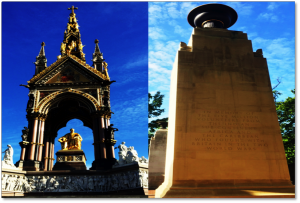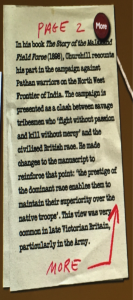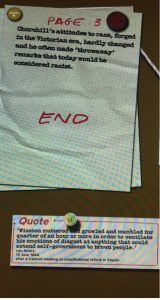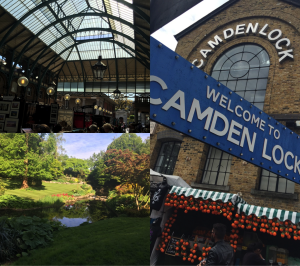Rendering judgment is typically easier for individuals who are able to remove themselves from the equation. People are often more able to come to an opinion about the actions and responsibilities of others than to appropriately evaluate their own — it’s a theme I’ve seen quite frequently in this trip, and it’s one I’ve found applies in my personal life as well. Here, I’m going to attempt to look at a bit of both.
This idea crept into my head on our ride out to Sachsenhausen. I’ll start with the backstory. We had visited Wannsee the day before, and I was really shaken by it. Racism really strikes me at the core — the crude differentiation between human and sub-human that the Nazis called “science” makes me feel physically ill. But as we talked with the tour guide, she unabashedly made the obvious explicit: none of this started or ended with the Nazis. Racial discrimination began far earlier and still continues today in so many ways. With this on my mind, my biggest takeaway was especially troubling. We entered the room where the Wannsee Conference was held, and a flowchart on the wall showed pictures and biographies of the men involved, as well as their rank within the NSDAP. One man on the chart was beneath all the rest, and he bore one of the few names I recognized: Adolf Eichmann. Eichmann, the head of Nazi deportation efforts, was the lowest ranked officer in attendance.
I could not stop staring at Eichmann. Of all that I saw on this trip, his face haunts me more than anything else, and it’s because he’s so human. In the grand scheme of things, he was just doing grunt work — this is the guy Heydrich has rewriting all the documents about the Final Solution six times until he thought they looked good enough. It kills me that these words about providing “suitable treatment” to the Jewish people who survived labor camps was written in about an hour and a half during a brunch among colleagues at a pretty little lake house. Eichmann later said that, to these men, this was just business as usual over a nice cognac.
The way the Nazis were able to bureaucratize and normalize genocide is what scares me most. Before the war, Eichmann was nothing more than a bookkeeper’s son — a salesman and travel agent in Vienna. Many of the men at the same table with him had just finished law school. These people are just. like. us. That’s what makes how far they went so terrifying. No matter how much I study the Holocaust, it’s still hard for me to fathom that it was something that humans did to other humans in such recent history: that these monsters really were men.
On our way to Sachsenhausen, a few of us were discussing this idea of humanity and its darker side, but we did so on a different topic that’s also of personal importance to me. You see, I’m from Steubenville, Ohio. When I graduated from high school back in June of 2012, that might not have meant anything to most people, and in 2015, it might have faded from popular memory again. But in the years between, you’ve probably heard of it. Steubenville was the site of the infamous rape case that happened in August of 2012: two student athletes from my alma mater were convicted of raping an unconscious teenage girl from a neighboring school, and it hit national news. The case was emblematic of the problem of high school drinking and sex in today’s society, and Steubenville became synonymous with rape culture. Cameron, one of the guys on my trip, is doing some research on the case now for a play that’s been commissioned by the Big Ten Conference, and we delved into the topic of remembrance in Steubenville on the train. This play is tentatively titled Good Kids based on several residents’ quips in major news stories — from what I could gather, it centers on the inability of some to accept the serious wrongs that were done and their willingness to excuse rape with a “boys will be boys” attitude. These boys, they say, were generally good students, good athletes, and good friends, and they made a terrible mistake, but at the end of the day, they’re still good kids. And while I don’t know that that reflects the majority viewpoint in Steubenville, I would not dispute that it’s certainly a belief I’ve heard voiced.
As we discussed the play, Peter (another friend from the trip) mentioned how striking the comparison was when you considered our destination. It stopped me dead in my tracks, because I’d never had that thought before… and then the gears started to turn. I’d like to pause here to say that what follows will not be an attempt to make a direct comparison between these two events. But I will say that this comparison completely altered the way that I thought about remembrance, not only in Germany, but in every place we’ve been, because it made everything so much more real. The undeniable similarities between the two horrors are the questions they make you ask about humanity. Why would anyone do such a thing? How could they go this far? And finally, what I’ll be examining here: who is responsible?
The first analogous characters, and the most obvious at the time for me, were Eichmann and Heydrich. Because, much like my observations about Eichmann, the two boys in Steubenville didn’t seem so different from the rest of us to start. And just as Eichmann had a superior in Heydrich, my understanding is that of the two boys who perpetrated the rape, one was a ringleader, and the other was more of a follower, and both were responsible for terrible, terrible consequences. Neither was absolved legally, nor should they have been. And, as you may have guessed, this was the easiest portion of my reflection, because it’s still the type that allows me to remove myself from the equation. If I stopped here, the answer would still be true (albeit incomplete): these two were responsible for what happened.
But if you dig a bit deeper, the next level gets trickier. Another perspective we noticed in Berlin’s remembrance was that of German national responsibility. The notion of bystander culpability and of National Socialist actions as an extension of German culture was one that Berlin owned, which was impressive. It’s something Steubenville has struggled with a bit, because it’s easier to point at the individual perpetrators as if they’re the exception and not the rule. It’s easy to pick a scapegoat — especially ones who largely deserve it — and to hide in the shadows as if they’re an anomaly. The problem is that it just isn’t true. And just like the Nazis played on the antisemitism and other forms of racism that already existed in Germany to enact their Final Solution, the boys from my hometown who raped a young woman would not have been able to do so had it not been for the culture that surrounded them. There were only two boys who committed rape, and there were only two boys convicted for that night in August, but it would be a disservice to say that their actions were entirely independent. Most directly, there were older boys with them throughout the night, videotaping their actions and laughing at the cruel words they spoke in jest. There were people at various points in the night who could have intervened and did nothing, just as many neighbors of the deported Jews turned a blind eye because it was more comfortable. And on the more indirect end of the scale, there were plenty of us who laughed with friends who had blacked out over the weekend after too many cheap beers, and there were plenty more who inflated the egos of young student-athlete stars. I’ve come to believe that the small things like that add up to the actions they committed — while the line is hard to draw, it’s important to understand that even seemingly harmless acts can contribute to a much larger problem. Even men like Eichmann, whom we view as monsters today, were often relegated to inundated tasks such as drafting documents without physically massacring the millions whose death he commissioned. His mundane office behavior and the millions who stood silent while his schemes were being implemented helped to normalize the barbarities that happened. And just as Germany has accepted a national responsibility for its role, I believe the people of Steubenville must do the same.
I understand the shame that comes with that. At Sachsenhausen, Megan van Almsick mentioned that the memorials that span Berlin seem to spark a constant guilt in people who, in 2015, had nothing to do with the Holocaust. I was immediately reminded of two things. The first was one common reaction in Steubenville during the initial media storm: people wished it would all just go away — that what happened had happened, and that they felt terrible about it, but that they had no control over it and wanted the spotlight to shift from our small town so normalcy could return. The second, which applies in both scenarios, is Audre Lorde’s view on guilt as a response to anger — namely, that it is insufficient. We must be forced to think through difficult issues and confront them if we hope to avoid falling into the same traps in the future, but resorting to feelings of guilt often keeps individuals from critically engaging with the problem at hand. Whether in Berlin or at home, it is most important to meet these topics face-to-face, uncomfortable as they may be, and rise above guilt to genuine reflection on how to improve upon our past behaviors and attitudes if we aim to move beyond them. This shameful responsibility is not something we can ever truly “move on” from — it is an onus that we earned, that we deserve, and that we must build upon in order to shape a better future.
This is what I appreciated most about Berlin. Everywhere you look, their history is built right into the city. Bricked paths and remaining fragments allow the Wall to still run right through busy roadways; stumbling stones on neighborhood sidewalks bear the names of Jews who were deported from the same streets we walk; somber memorials spring up in the midst of parks, buildings, and riverbends. Berlin has not forgotten, and yet it still lives so fully in the here and now. The same barrier that once served to divide people now unites them at Mauerpark, where I ate lunch with people from all over the world while sitting on the wall itself. This city has managed a feat that no other city I’ve seen has even attempted: even with a darker history than most, Berlin has allowed itself to thrive not in spite of but in conjunction with its past.






